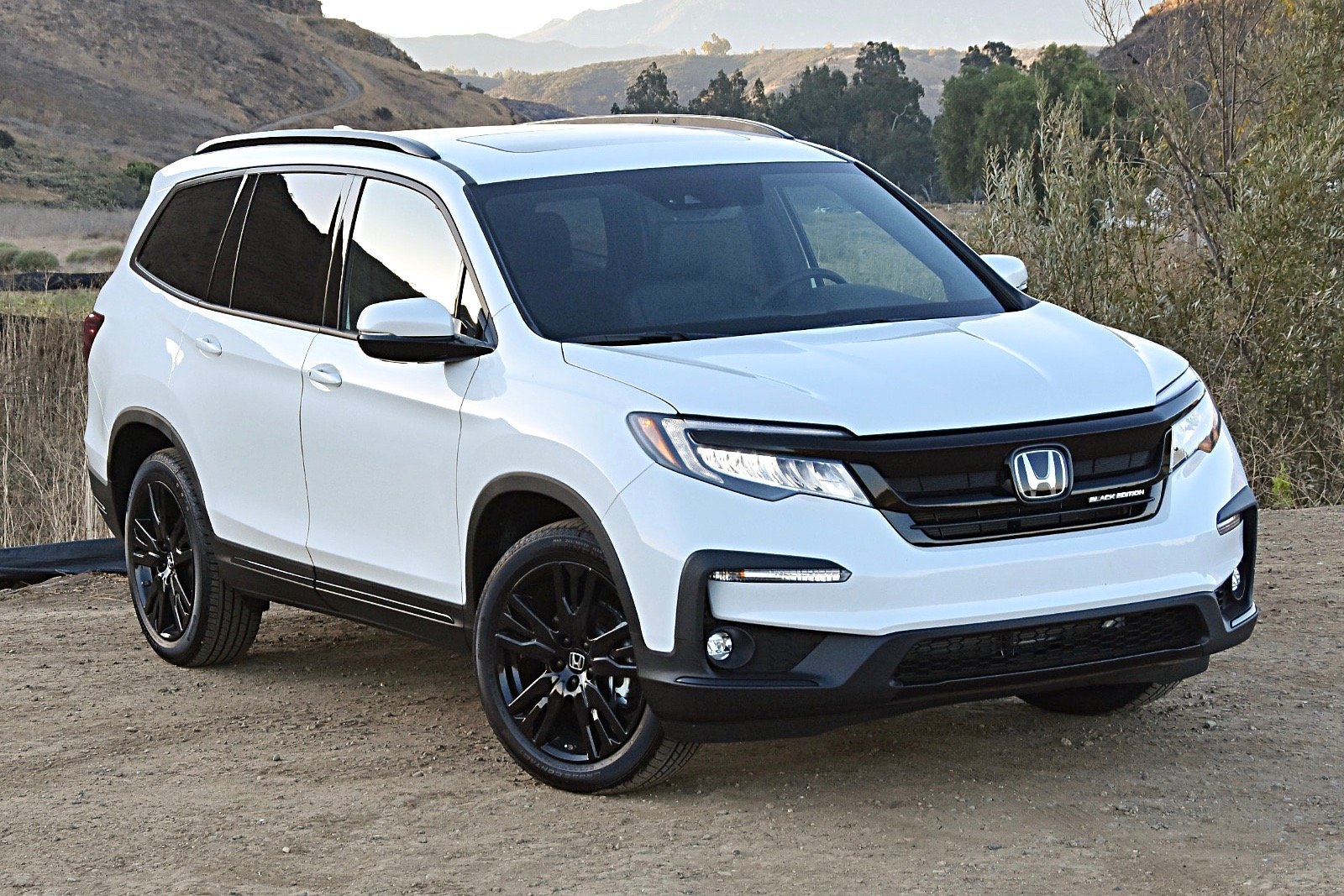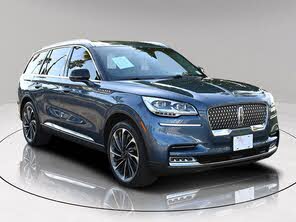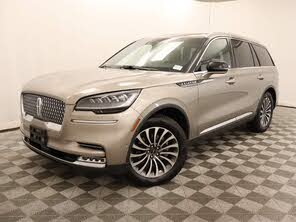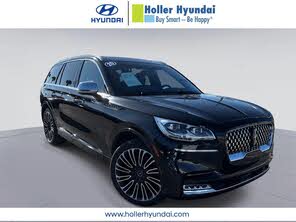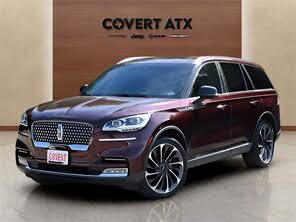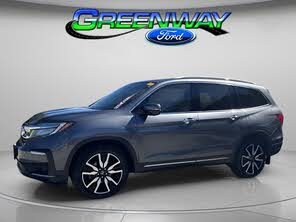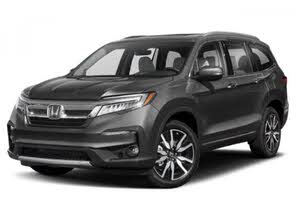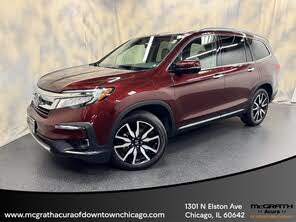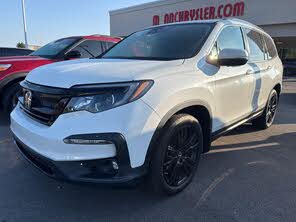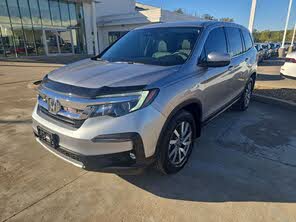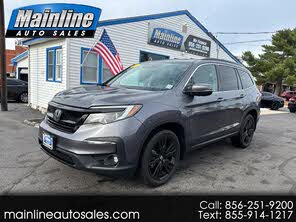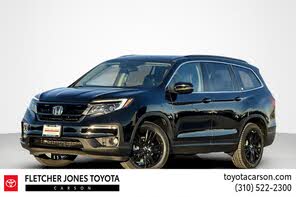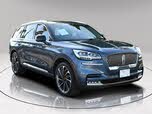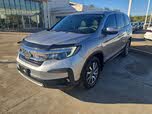2020 Lincoln Aviator vs 2021 Honda Pilot
Overview | |
MSRP$51,100 | MSRP$32,550 |
Listings591 | Listings994 |
Ratings & Reviews | |
User Reviews | User Reviews |
Expert reviews8.2 out of 10 | Expert reviews7.2 out of 10 |
Pros
Cons
| Pros
Cons
|
2020 Lincoln Aviator Reviews SummaryThe heyday for Lincoln was more than a half-century ago. Those postwar years of prosperity and optimism were the perfect time for cars like the Continental and others. They delivered comfort and luxury, wrapped in midcentury modern styling. Even as recently as the 1990s, Lincoln was still a popular brand, riding the SUV craze with its Navigator. But after the turn of the century, Lincoln lost its ability to create new designs and looked inward and backward. Sure, retro-themed cars like the redesigned Mustang, PT Cruiser, and Chevy HHR had turned some heads, but none of those came from luxury brands. The BMWs and Mercedes of the world were all looking forward and pushing the envelope for contemporary automotive design. Meanwhile, Lincoln offered the MKX, which was based on the Ford Edge and featured ’66 Continental styling. Neat in a vacuum, but off-base compared to the modern luxury market. This experimental phase with various retro looks coincided with the move to the MK-# alphabet-soup naming convention and big improvements in the Ford lineup, where top-end trims of the Fusion overlapped with an entry-level trim of the MKZ. The combination left Lincoln a confusing, anonymous afterthought in the modern luxury game. But Lincoln is finally ready to change all that. It has a new cohesive design language, its focus is once again on luxury, and the three-letter naming convention that never meant anything to anyone other than Lincoln marketers is gone. The brand led with the 2017 Continental and 2018 Navigator, which are each impressive in their own right. But the company's lineup is growing and now includes the all-new 2020 Lincoln Aviator. Named after a luxury variant of the 2002-2005 Ford Explorer, this new Aviator is also based on the contemporary Explorer platform, but it's a luxury vehicle in its own right. Much of the success of the Lincoln brand may hinge on this midsize, 3-row luxury SUV, so you need to consider its competition, such as the Audi Q7, Infiniti QX60, and all-new Cadillac XT6. Read on to learn if Lincoln’s take on luxury will stand out in a crowded competitive field. | |
2021 Honda Pilot Reviews SummaryIt’s been seven years since Honda last redesigned the Pilot, the automaker’s popular midsize three-row crossover SUV. In most ways, age has been kind to it, but to love a 2021 Honda Pilot you must first live with one. Unlike some competitors, the styling is not a strong suit. Rather, it is the Pilot’s interior, powertrain, driving dynamics, and simple but useful technology that makes you appreciate it each and every day. Well, that, and the cheap lease payment. | |
No video found | |
Popular Features & Specs | |
Engine3.0L 400 hp V6 | Engine3.5L 280 hp V6 |
Drive TrainRWD | Drive TrainFWD |
Seating Capacity7 | Seating Capacity8 |
Horsepower | Horsepower280 hp @ 6000 rpm |
MPG City18 | MPG City20 |
MPG Highway26 | MPG Highway27 |
Engine | |
Engine Name3.0L 400 hp V6 | Engine Name3.5L 280 hp V6 |
Torque | Torque262 lb-ft @ 4700 rpm |
Horsepower | Horsepower280 hp @ 6000 rpm |
DrivetrainRWD | DrivetrainFWD |
Fuel Economy | |
MPG City18 | MPG City20 |
MPG Highway26 | MPG Highway27 |
Interior | |
Seating Capacity7 | Seating Capacity8 |
Safety | |
Front Crash Overall5 | Front Crash Overall4 |
Side Crash Overall5 | Side Crash Overall5 |
Dimensions & Capacity | |
Cargo Space18.3 cu ft | Cargo Space16.5 cu ft |
Curb Weight4764 lbs | Curb Weight3982 lbs |
Height69.8 in | Height70.6 in |
Length199.3 in | Length196.5 in |
Width89.9 in | Width78.6 in |
Wheelbase119.1 in | Wheelbase111.0 in |
Maximum Payload | Maximum Payload1563 lbs |
Number of doors4 | Number of doors4 |
Maximum Towing Capacity | Maximum Towing Capacity3500 lbs |
Overview | ||
MSRP | $51,100 | $32,550 |
Listings | ||
Ratings & Reviews | ||
User reviews | ||
Expert reviews | 8.2 out of 10Read full review | 7.2 out of 10Read full review |
Pros & cons | Pros
Cons
| Pros
Cons
|
Summary | The heyday for Lincoln was more than a half-century ago. Those postwar years of prosperity and optimism were the perfect time for cars like the Continental and others. They delivered comfort and luxury, wrapped in midcentury modern styling. Even as recently as the 1990s, Lincoln was still a popular brand, riding the SUV craze with its Navigator. But after the turn of the century, Lincoln lost its ability to create new designs and looked inward and backward. Sure, retro-themed cars like the redesigned Mustang, PT Cruiser, and Chevy HHR had turned some heads, but none of those came from luxury brands. The BMWs and Mercedes of the world were all looking forward and pushing the envelope for contemporary automotive design. Meanwhile, Lincoln offered the MKX, which was based on the Ford Edge and featured ’66 Continental styling. Neat in a vacuum, but off-base compared to the modern luxury market. This experimental phase with various retro looks coincided with the move to the MK-# alphabet-soup naming convention and big improvements in the Ford lineup, where top-end trims of the Fusion overlapped with an entry-level trim of the MKZ. The combination left Lincoln a confusing, anonymous afterthought in the modern luxury game. But Lincoln is finally ready to change all that. It has a new cohesive design language, its focus is once again on luxury, and the three-letter naming convention that never meant anything to anyone other than Lincoln marketers is gone. The brand led with the 2017 Continental and 2018 Navigator, which are each impressive in their own right. But the company's lineup is growing and now includes the all-new 2020 Lincoln Aviator. Named after a luxury variant of the 2002-2005 Ford Explorer, this new Aviator is also based on the contemporary Explorer platform, but it's a luxury vehicle in its own right. Much of the success of the Lincoln brand may hinge on this midsize, 3-row luxury SUV, so you need to consider its competition, such as the Audi Q7, Infiniti QX60, and all-new Cadillac XT6. Read on to learn if Lincoln’s take on luxury will stand out in a crowded competitive field. | It’s been seven years since Honda last redesigned the Pilot, the automaker’s popular midsize three-row crossover SUV. In most ways, age has been kind to it, but to love a 2021 Honda Pilot you must first live with one. Unlike some competitors, the styling is not a strong suit. Rather, it is the Pilot’s interior, powertrain, driving dynamics, and simple but useful technology that makes you appreciate it each and every day. Well, that, and the cheap lease payment. |
Video | No video found | |
Popular Features & Specs | ||
Engine | 3.0L 400 hp V6 | 3.5L 280 hp V6 |
Drive Train | RWD | FWD |
Seating Capacity | 7 | 8 |
Horsepower | 280 hp @ 6000 rpm | |
MPG City | 18 | 20 |
MPG Highway | 26 | 27 |
Engine | ||
Engine Name | 3.0L 400 hp V6 | 3.5L 280 hp V6 |
Torque | 262 lb-ft @ 4700 rpm | |
Horsepower | 280 hp @ 6000 rpm | |
Drivetrain | RWD | FWD |
Fuel Economy | ||
MPG City | 18 | 20 |
MPG Highway | 26 | 27 |
Interior | ||
Seating Capacity | 7 | 8 |
Safety | ||
Front Crash Overall | 5 | 4 |
Side Crash Overall | 5 | 5 |
Dimensions & Capacity | ||
Cargo Space | 18.3 cu ft | 16.5 cu ft |
Curb Weight | 4764 lbs | 3982 lbs |
Height | 69.8 in | 70.6 in |
Length | 199.3 in | 196.5 in |
Width | 89.9 in | 78.6 in |
Wheelbase | 119.1 in | 111.0 in |
Maximum Payload | 1563 lbs | |
Number of doors | 4 | 4 |
Maximum Towing Capacity | 3500 lbs | |
The 2020 Lincoln Aviator slotted below the Navigator and above the compact MKC and its replacement, the Lincoln Corsair. Lincoln's return to using real vehicle names was a positive shift, moving away from the old alphabet-soup naming convention. The Aviator featured a unified design across Lincoln's lineup, with handsome headlights and an upright chrome grille. Its roofline tapered, giving it an elongated look, and the low, wide beltline added a boat-like appearance. Inside, the Aviator's cabin boasted a flowing design with soft-touch materials and selective use of brightwork. The seats were both elegant and sturdy, with shifter buttons resembling piano keys. The front seats were incredibly comfortable, using plush leather throughout, even in areas where it wasn't necessary, indicating a deep commitment to luxury. The Aviator also had unique touches like a massive panoramic moonroof and warning jingles recorded by the Detroit Symphony Orchestra.
The 2021 Honda Pilot aimed to balance styling with reliability, safety, comfort, and performance. A 2019 refresh gave the SUV a more rugged appearance, and the 2020 Black Edition introduced a popular blacked-out look. However, the exterior design remained an acquired taste. The Pilot was available in seven trims: LX, EX, EX-L, Special Edition, Touring, Elite, and Black Edition, with prices ranging from $32,250 to $49,920. Front-wheel drive was standard, with all-wheel drive available for an extra $2,000, except on the Elite and Black Edition trims, where AWD was standard. The new Special Edition trim added black 20-inch alloy wheels, blacked-out exterior trim, wireless smartphone charging, and a hands-free power tailgate. The Black Edition, which we drove, came fully loaded, with exclusive black leather upholstery, red-tinted and perforated seat inserts, red contrast stitching, and red ambient lighting. However, the black mats were a challenge to clean, especially with white-haired pets.










The 2020 Lincoln Aviator came standard with a twin-turbocharged 3.0-liter V6 engine, producing 400 horsepower and 415 pound-feet of torque. The Grand Touring trim combined this engine with a 100-hp electric motor, resulting in a net 494 hp and 630 lb-ft of torque. Both powertrains used a 10-speed automatic transmission, with the base V6 offering rear-wheel drive or all-wheel drive, while the plug-in hybrid was AWD only. Both versions could accelerate from 0-60 mph in about 4 seconds. The Grand Touring's hybrid setup provided smooth, confident acceleration and improved fuel efficiency, with a combined 23 mpg and a 21-mile electric-only range. The Aviator's steering was light, and its brakes were cushioned but effective. The driving experience was refined, with an "Excite" drive mode for a more dynamic feel. Fuel economy for the conventional Aviator was 18 mpg city, 26 highway, and 21 combined for RWD, and 17, 24, and 20 for AWD.
The 2021 Honda Pilot featured a 3.5-liter V6 engine with 280 horsepower and 262 pound-feet of torque. A nine-speed automatic transmission powered the front wheels, with an available torque-vectoring all-wheel-drive system. The Pilot offered a comfortable ride and unexpectedly athletic handling, thanks to its MacPherson strut front and multi-link rear suspension. The torque-vectoring AWD system, 20-inch wheels, and 245/50 tires contributed to the fun on pavement. The steering was well-weighted and responsive, and the brakes were properly calibrated, though they could heat up and vibrate with prolonged use. Off-road capability was limited by the Pilot's 7.3 inches of ground clearance and all-season tires. Fuel-saving measures included variable-cylinder management and automatic engine stop/start, with an EPA rating of 22 mpg combined for AWD. The test vehicle averaged 21.5 mpg on the testing loop.
The 2020 Lincoln Aviator, with its three rows, competed with the Audi Q7, Infiniti QX60, Mercedes-Benz GLE, Land Rover Discovery, and Cadillac XT6. The optional second-row captain’s chairs were fantastic, while the power-closing third row was adequate for adults but best suited for kids on longer trips. Dropping the second and third rows provided 77 cubic feet of cargo space, comparable to the Cadillac XT6. The Aviator had some confusing controls, like the door handles and seat adjustments, which required navigating a touchscreen menu. The door-release function was also unconventional, with a button instead of a handle, which could be problematic in emergencies.
The 2021 Honda Pilot offered plenty of room for a family, seating up to eight people with a second-row bench seat. The test vehicle's leather-wrapped, heated, and ventilated front seats were comfortable and supportive, with 10-way power adjustment for the driver and four-way for the front passenger. Second-row captain’s chairs were optional on the Touring trim and standard on Elite and Black Edition models, where they were also heated. These chairs were nearly as comfortable as the front seats and slid forward for easier third-row access. The third-row seat was mid-pack in comfort, with a low and flat bottom cushion. Storage was abundant, with compartments in the door panels, center console, and front seatback pockets. The Pilot offered 16.5 cubic feet of cargo space behind the third row, 46.8 cubic feet with the third row folded, and a maximum of 83.9 cubic feet.
The 2020 Lincoln Aviator came standard with the Sync 3 infotainment system, featuring a 10.1-inch touchscreen in a landscape layout. This setup provided a better interface for Apple CarPlay and Android Auto compared to the Ford Explorer's portrait layout. The Aviator also had a fully digital instrument panel and a massive head-up display, which presented information in a minimalist and unobtrusive manner.
Most 2021 Honda Pilots included an 8-inch touchscreen infotainment system with Bluetooth, Apple CarPlay, Android Auto, text-messaging support, satellite radio, and a basic version of HondaLink connected services. The Special Edition added wireless phone charging, while the Touring trim included navigation, a WiFi hotspot, a 10-speaker premium audio system, and more. The infotainment system was adequate but had a small screen and lacked a tuning knob. The voice-recognition technology required specific prompts, and HondaLink services were limited to higher trims. The Touring trim also added a rear-seat entertainment system, a 115-volt power outlet, an HDMI port, and a Cabin Talk feature for easier communication with rear-seat passengers.
The 2020 Lincoln Aviator came with standard safety features, including front and side-impact airbags, traction control, and a tire pressure monitoring system. The Lincoln Co-Pilot360 suite included forward-collision avoidance, lane-departure warning, adaptive cruise control, automatic high beams, blind-spot monitoring, and a head-up display.
The 2021 Honda Pilot featured Honda Sensing as standard, which included adaptive cruise control, forward-collision warning, automatic emergency braking, and lane-keeping assist. Starting with the EX trim, the Pilot also had blind-spot monitoring and rear cross-traffic warning. The older version of Honda Sensing worked but lacked smoothness and refinement. The Pilot received favorable crash-test ratings, with a five-star overall rating from the NHTSA and "good" ratings from the IIHS, except for an "acceptable" score for front passenger small overlap frontal-impact protection.
CarGurus highlights
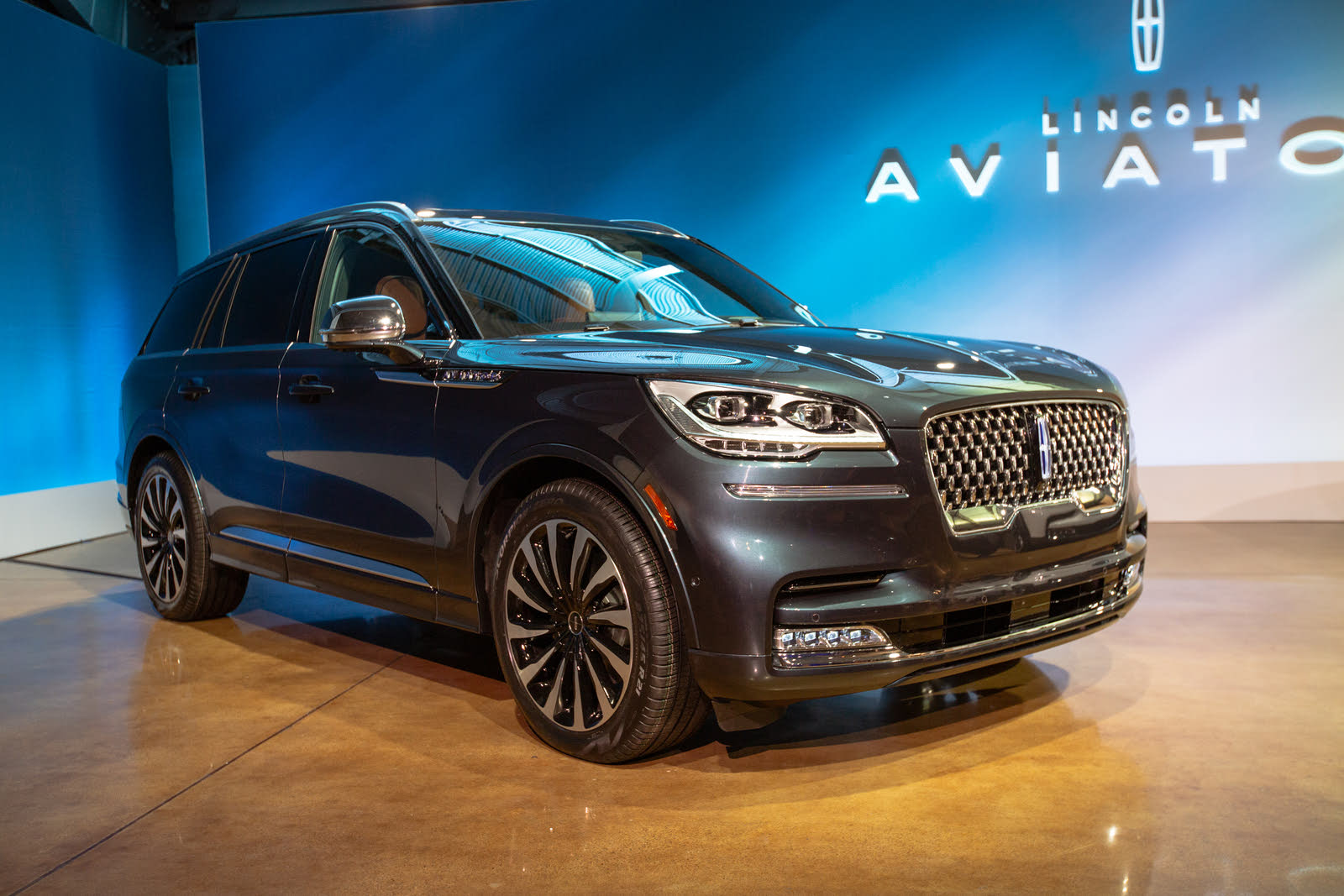
According to CarGurus experts, the overall rating for the 2020 Lincoln Aviator is 8.2 out of 10, while the 2021 Honda Pilot scores 7.2 out of 10. Based on these ratings, the 2020 Lincoln Aviator is the recommended choice, offering a more luxurious and powerful driving experience with unique features that set it apart from the competition.
Choose the 2020 Lincoln Aviator if:
- You prioritize a luxurious and comfortable interior with high-quality materials.
- You want a powerful engine with a plug-in hybrid option for better fuel efficiency.
- You appreciate unique features like orchestral warning jingles and a massive panoramic moonroof.
Choose the 2021 Honda Pilot if:
- You need a spacious and practical SUV with seating for up to eight people.
- You value a comfortable ride with unexpectedly athletic handling.
- You want a family-friendly vehicle with abundant storage and a rear-seat entertainment system.
CarGurus highlights

According to CarGurus experts, the overall rating for the 2020 Lincoln Aviator is 8.2 out of 10, while the 2021 Honda Pilot scores 7.2 out of 10. Based on these ratings, the 2020 Lincoln Aviator is the recommended choice, offering a more luxurious and powerful driving experience with unique features that set it apart from the competition.
Choose the 2020 Lincoln Aviator if:
Shop Now- You prioritize a luxurious and comfortable interior with high-quality materials.
- You want a powerful engine with a plug-in hybrid option for better fuel efficiency.
- You appreciate unique features like orchestral warning jingles and a massive panoramic moonroof.
Choose the 2021 Honda Pilot if:
Shop Now- You need a spacious and practical SUV with seating for up to eight people.
- You value a comfortable ride with unexpectedly athletic handling.
- You want a family-friendly vehicle with abundant storage and a rear-seat entertainment system.

By: CarGurus + AI
At CarGurus, our team of experienced automotive writers remain at the heart of our content operation, conducting hands-on car tests and writing insightful guides that are backed by years of industry experience. To complement this, we are harnessing AI to make our content offering more diverse and more helpful to shoppers than ever. To achieve this, our AI systems are based exclusively on CarGurus content, ratings and data, so that what we produce is both unique to CarGurus, and uniquely helpful to car shoppers.
